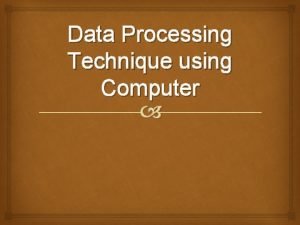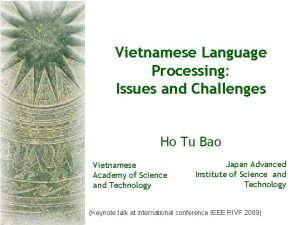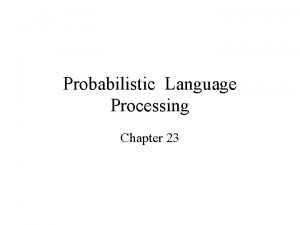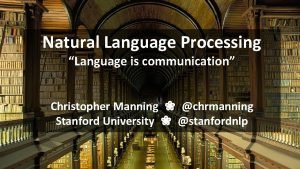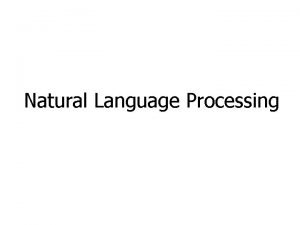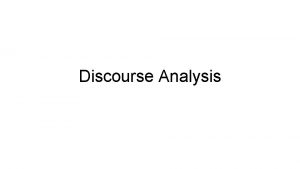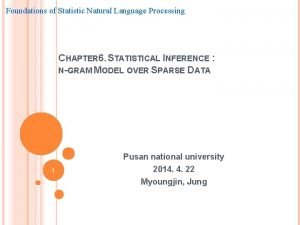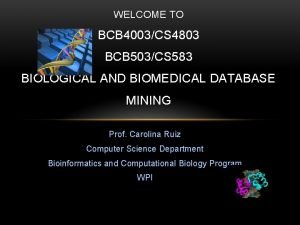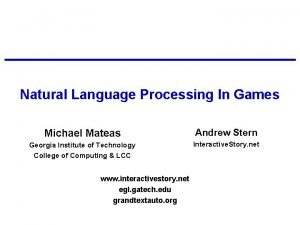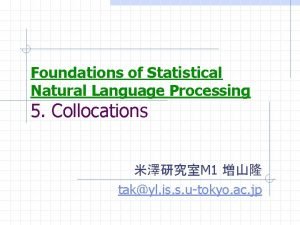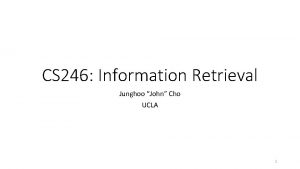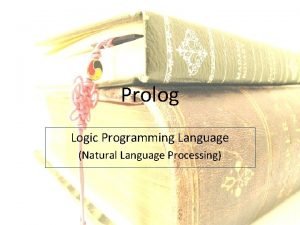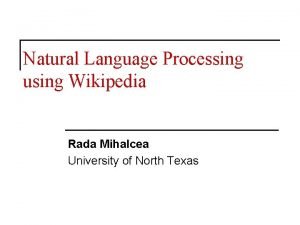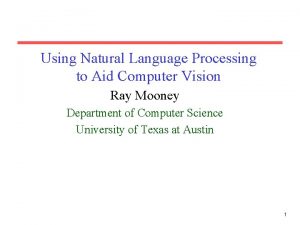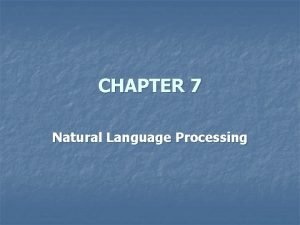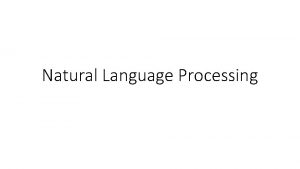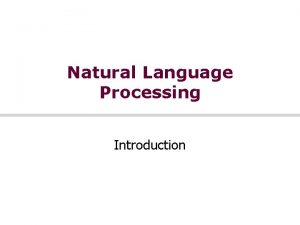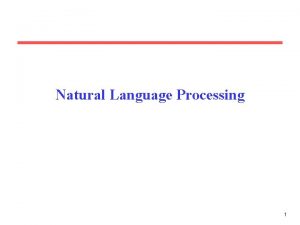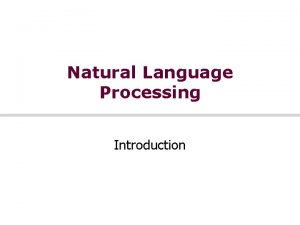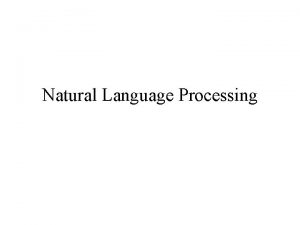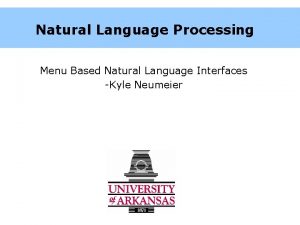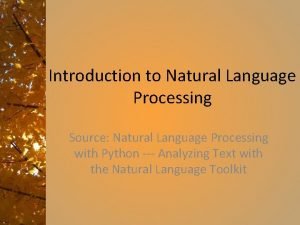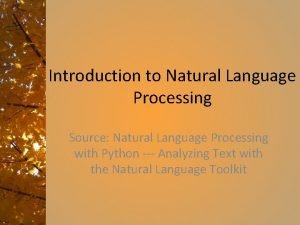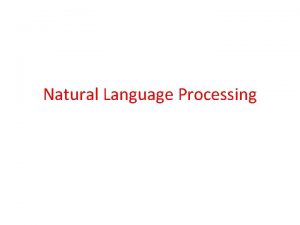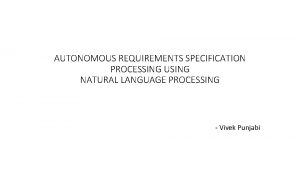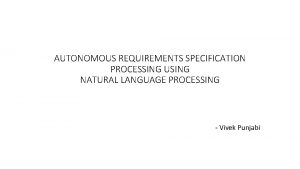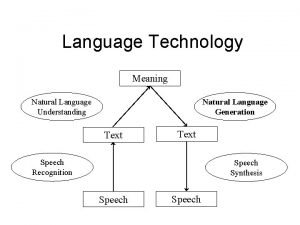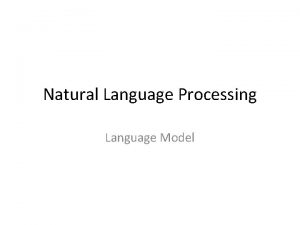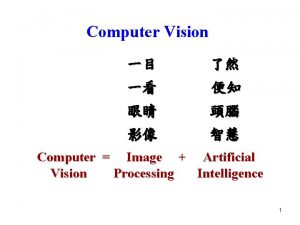Using Natural Language Processing to Aid Computer Vision



















- Slides: 19

Using Natural Language Processing to Aid Computer Vision Ray Mooney Department of Computer Science University of Texas at Austin 1

My Initial Motivation for Exploring Grounded Language Learning • I became frustrated having to manually annotate sentences with formal meaning representations (MRs) to train semantic parsers. • I hoped to automatically extract MRs from the perceptual context of situated language. • However, computer vision is generally not capable enough yet to provide the MRs needed for semantic parsing. • Therefore, I focused on grounded language learning in virtual worlds to circumvent computer vision. 2

Computer Vision is Hard • Both language understanding and vision are “AI complete” problems. • However, in many ways, I think vision is the harder problem. 3

Text Really Helps Language Learning • Both speech and visual perception begin with a complex analog signal (sound vs. light waves). • However, for language we have orthographic text that intermediates between analog signal and semantic representation. • Training on large, easily available corpora of text dramatically benefits learning for language. • No such pervasive, data rich, intermediate representation exists for vision. 4

Dimensionality Language vs. Vision • Language input is fundamentally 1 -d, i. e. linear sequences of sounds, phonemes, or words. • Vision is fundamentally a 2 -d (arrays of pixels), 2 ½ - d (depth maps) or 3 -d (world model) problem. • Therefore, the “curse of dimensionality” makes vision a much harder problem. 5

Biological Hardware Vision vs. Language • Humans arguably have a greater amount of neural hardware dedicated to vision than to language. • Therefore, matching human performance on vision may be computationally more complex. 6

Biological Evolution Vision vs. Language • Vision has a much longer “evolutionary history” than language. – First mammals: 200 -250 million years ago (MYA) – First human language: Homo habilis, 2. 3 MYA • Therefore, a much more complex neural system could have evolved for vision compared to language. 7

Language Helping Vision • Now I feel sorry for my poor computer vision colleagues confronting an even harder problem. • So I’d like to help them, instead of expecting them to help me. As Jerry Maguire said: Help me, help you! 8

NL-Acquired Knowledge for Vision • Many types of linguistic knowledge or knowledge “extracted” from text can potentially aid computer vision. 9

Textual Retrieval of Images • Most existing image search is based on retrieving images with relevant nearby text. • A variety of computer vision projects have used text-based image search to automatically gather (noisy) training sets for object recognition. • Various ways of dealing with the noise in the resulting data: – Multiple-instance learning – Cleanup results with crowd-sourcing 10

Lexical Ontologies • Image. Net built a large-scale hierarchical database of images by using the Word. Net ontology (Deng et al. CVPR-09) • “Hedging Your Bets” method uses Image. Net hierarchy to classify object as specifically as possible while maintaining high accuracy (Deng et al. CVPR-12) 11

Subject-Verb-Object (SVO) Correlations • We developed methods for using probability estimates of SVO combinations to aid activity recognition (Motwani & Mooney, ECAI-12) and sentential NL description (Krishnamoorthy et al. , AAAI 13) for You. Tube videos. • SVO probabilities are estimated using a smoothed trigram “language model” trained on several large dependency-parsed corpora. • Similar statistics can also be used to predict verbs for describing images based on the detected objects (Yang et al. , EMNLP 2011). 12

Object-Activity-Scene Correlations • Can use co-occurrence statistics mined from text for objects, verbs, and scenes to improve joint recognition of these from images or videos. • Such statistics have been used to help predict scenes from objects and verbs (Yang et al. EMNLP 2011). 13

Object-Object Correlations • Could use object-object co-occurrence statistics mined form text to acquire knowledge that could aid joint recognition of multiple objects in a scene. • An “elephant” is more likely to be seen in the same image as a “giraffe” than in the same image as a “penguin” 14

Scripts Activity-Activity Correlations and Orderings • Knowledge of stereotypical sequences of actions/events can be mined from text (Chambers & Jurafsky, 2008). • Such knowledge could be used to improve joint recognition of sequences of activities from video. – Opening a bottle is typically followed by drinking or pouring. 15

Transferring Algorithmic Techniques from Language to Vision • Text classification suing “bag of words” to image classification using “bag of visual words” • Linear CRFs for sequence labeling (e. g. POS tagging) for text to 2 -d mesh CRFs for pixel classification in images. • HMMs for speech recognition to HMMs for activity recognition in videos. 16

Other Ways Language can Help Vision? Your Idea Here 17

Conclusions • Its easier to use language processing to help computer vision than the other way around. • For a variety of reasons computer vision is harder than NLP. • Knowledge about or from language can be used to help vision in various ways. Help me, help you, help me! 18

Recent Spate of Workshops on Grounded Language • NSF 2011 Workshop on Language and Vision • AAAI-2011 Workshop on Language-Action Tools for Cognitive Artificial Agents: Integrating Vision, Action and Language • NIPS-2011 Workshop on Integrating Language and Vision • NAACL-2012 Workshop on Semantic Interpretation in an Actionable Context • AAAI-2012 Workshop on Grounding Language for Physical Systems • NAACL-2013 Workshop on Vision and Language • CVPR-2013 Workshop on Language for Vision • UW-MSR 2013 Summer Institute on Understanding Situated Language 19
 Human vision vs computer vision
Human vision vs computer vision Font detector
Font detector Data processing using computer
Data processing using computer Natural language processing vietnamese
Natural language processing vietnamese Probabilistic model natural language processing
Probabilistic model natural language processing Natural language processing nlp - theory lecture
Natural language processing nlp - theory lecture Markov chain natural language processing
Markov chain natural language processing Christopher manning stanford
Christopher manning stanford Contoh bahasa alami
Contoh bahasa alami Discourse analysis nlp
Discourse analysis nlp Nlp lecture notes
Nlp lecture notes Language
Language Natural language processing fields
Natural language processing fields Statistical natural language processing
Statistical natural language processing Natural language processing nlp - theory lecture
Natural language processing nlp - theory lecture Natural language processing games
Natural language processing games Foundations of statistical natural language processing
Foundations of statistical natural language processing Junghoo cho ucla
Junghoo cho ucla Prolog natural language processing
Prolog natural language processing Natural language processing wikipedia
Natural language processing wikipedia


